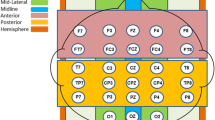Abstract
Children identified as normal or as specifically language impaired (SLI) were given speech, language, and intelligence testing on a longitudinal basis. Fourteen normal and 29 SLI children between the ages of 4 1/2 and 8 years were tested at Time 1. They were retested three to four years later when they were 8 to 12 years old. The results indicated that both the normal and the SLI children continued to develop skills in receptive and expressive language and speech articulation across the 3- to 4-year period intervening between evaluations. Overall, however, the SLI children appeared to develop language skills at a slower than normal rate and 80% of them remained language impaired at Time 2. In addition, the majority of the SLI children manifested reading impairment at Time 2, while none of the normal children did so. The implications for the educational management of SLI children are discussed.
Similar content being viewed by others
References
Aram, D. H. and Nation, J. E. 1980. Preschool language disorders and subsequent language and academic difficulties.Journal of Communication Disorders 13:159–170.
Benton, A. L. 1964. Developmental aphasia and brain damage.Cortex 1:40–42.
Bernstein, L. E., Stark, R. E., and Tallal, P. 1982. Speech perception development in language-impaired children: A four-year follow-up study. Paper presented at the Annual Convention of the American Speech-Language-Hearing Association.
Carrow, E. 1972.Test of Auditory Comprehension of Language. Austin, Texas: Learning Concepts.
DeRenzi, E. and Vignolo, L. A. 1962. A sensitive test to detect respective disturbances in aphasics.Brain 85:665–678.
Drash, P. W. and Leibowitz, J. M. 1973. Operant conditioning of speech and language in the nonverbal retarded child: Recent advances.Pediatric Clinics of North America 20:233–243.
Dunn, L. M. 1959.Peabody Picture Vocabulary Test. Circle Pines, Minnesota: American Guidance Service.
Gates, A. T. and MacGinitie, W. A. 1972.Gates-MacGinitie Reading Tests. New York: Columbia University, Teachers’ College Press.
Geschwind, N. 1978. Anatomical foundations of language and dominance. Paper presented at NINCDS Symposium entitled “The Neurological Bases of Language Disorders in Children.” Bethesda, MD.
Guess, D. A. 1969. Functional analysis of receptive language and productive speech: Acquisition of the plural morpheme.Journal of Applied Behavioral Analysis 2:55–64.
Hall, P. K. and Tomblin, J. B. 1978. A follow-up study of children with articulation and language disorders.Journal of Speech and Hearing Disorders 43:227–241.
Hollingshead, A. B. 1957. Two factor index of social position. Unpublished MS. New Haven, Connecticut.
Kaplan, E. and Goodglass, H. 1978.Boston Naming Test. Experimental Edition.
Kirk, S. J., McCarthy, J. and Kirk, W. D. 1968.Illinois Test of Psycholinguistic Abilities. Urbana: University of Illinois Press.
Lee, L. L. 1969.Northwestern Syntax Screening Test. Evanston, Illinois. Northwestern University Press.
McDonald, J. D. and Blott, J. P. 1974. Environmental language intervention: A rationale for diagnostic and training strategy through rules, context and generalization.Journal of Speech and Hearing Disorders 39:395–415.
McGinnis, M. A. 1963.Aphasic Children: Identification and Education by the Associative Method. Washington, DC: Volta Bureau.
Morley, M. 1965.Development and Disorders of Speech in Childhood. Edinburgh: Livingstone.
Siegel, S. 1956.Nonparametric Statistics for the Behavioral Sciences. New York: McGraw-Hill.
Spencer, W. N. 1958. Memory for Sentences Test. Doctoral Dissertation. Northwestern University.
Stark, R. E. and Tallal, P. 1980. Final Report. Sensory and perceptual functioning of young children with and without delayed language development. Contract NS-5-2323 from NINCDS.
Strominger, A. Z. and Bashir, A. S. 1977. Longitudinal study of language-delayed children. Paper presented at the Annual Convention of the American Speech-Language-Hearing Association.
Templin, M. and Darley, F. 1960.The Templin-Darley Test of Articulation. Iowa City: Iowa City Bureau of Educational Research.
Wechsler, D. 1963.Wechsler Preschool and Primary Scale of Intelligence. New York: The Psychological Corporation.
Wechsler, D. 1974.Wechsler Intelligence Scale for Children—Revised (WISC-R). New York: The Psychological Corporation.
Whitaker, H. and Noll, J. D. 1972. Some linguistic parameters of the Token Test.Neuropsychologia 10:395–404.
Author information
Authors and Affiliations
Additional information
Research supported by the March of Dimes, Grant #12-84.
Rights and permissions
About this article
Cite this article
Stark, R.E., Bernstein, L.E., Condino, R. et al. Four-year follow-up study of language impaired children. Annals of Dyslexia 34, 49–68 (1984). https://doi.org/10.1007/BF02663613
Issue Date:
DOI: https://doi.org/10.1007/BF02663613




